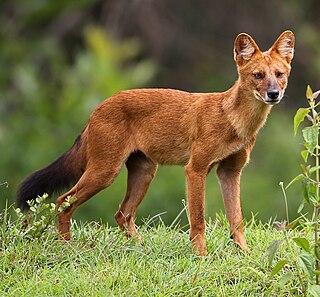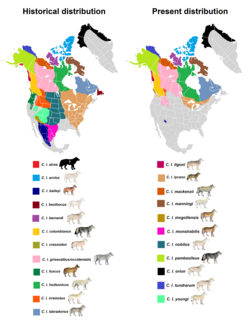Related Research Articles

The coyote is a species of canine native to North America. It is smaller than its close relative, the wolf, and slightly smaller than the closely related eastern wolf and red wolf. It fills much of the same ecological niche as the golden jackal does in Eurasia. The coyote is larger and more predatory and was once referred to as the American jackal by a behavioral ecologist. Other historical names for the species include the prairie wolf and the brush wolf.

The dhole is a canid native to Central, South, East, and Southeast Asia. Other English names for the species include Asian wild dog, Asiatic wild dog, Indian wild dog, whistling dog, red dog, and mountain wolf. It is genetically close to species within the genus Canis, but distinct in several anatomical aspects: its skull is convex rather than concave in profile, it lacks a third lower molar and the upper molars sport only a single cusp as opposed to between two and four. During the Pleistocene, the dhole ranged throughout Asia, Europe, and North America but became restricted to its historical range 12,000–18,000 years ago.

The wolf, also known as the gray wolf or grey wolf, is a large canine native to Eurasia and North America. More than thirty subspecies of Canis lupus have been recognized, and gray wolves, as colloquially understood, comprise non-domestic/feral subspecies. The wolf is the largest extant member of the family Canidae, males averaging 40 kg (88 lb) and females 37 kg (82 lb). Wolves measure 105–160 cm (41–63 in) in length and 80–85 cm (31–33 in) at shoulder height. The wolf is also distinguished from other Canis species by its less pointed ears and muzzle, as well as a shorter torso and a longer tail. The wolf is nonetheless related closely enough to smaller Canis species, such as the coyote and the golden jackal, to produce fertile hybrids with them. The banded fur of a wolf is usually mottled white, brown, gray, and black, although subspecies in the arctic region may be nearly all white.

Colo was a western gorilla widely known as the first gorilla to be born in captivity anywhere in the world and as the oldest known gorilla in the world. Colo was born at the Columbus Zoo and Aquarium to Millie Christina (mother) and Baron Macombo (father), and lived there for her entire life. She was briefly called "Cuddles" before a contest was held to officially name her. Colo's name was derived from the place of her birth, Columbus, Ohio.

Pack is a social group of conspecific canines. Not all species of canids form packs; for example, small canids like the red fox do not. Pack size and social behaviour within packs varies across species.

The Sawtooth Wilderness is a federally-protected wilderness area that covers 217,088 acres (87,852 ha) of the state of Idaho. Managed by the U.S. Forest Service in the U.S. Department of Agriculture, it was designated the Sawtooth Primitive Area in 1937 to preserve the exceptional scenic beauty of the Sawtooth Mountains. On August 22, 1972 Public Law 92-400 designated the Primitive Area as the Sawtooth Wilderness and part of the newly created Sawtooth National Recreation Area. As part of the National Wilderness Preservation System, the Sawtooth Wilderness is an area where human development and use are restricted and people are to remain only visitors. According to the United States Environmental Protection Agency, the Sawtooth Wilderness has some of the clearest air in the lower 48 states.

Sawtooth National Forest is a National Forest that covers 2,110,408 acres in the U.S. states of Idaho and Utah. Managed by the U.S. Forest Service in the U.S. Department of Agriculture, it was originally named the Sawtooth Forest Reserve in a proclamation issued by President Theodore Roosevelt on May 29, 1905. On August 22, 1972 a portion of the forest was designated as the Sawtooth National Recreation Area (SNRA), which includes the Sawtooth, Cecil D. Andrus–White Clouds, and Hemingway–Boulders wilderness areas. The forest is managed as four units: the SNRA and the Fairfield, Ketchum, and Minidoka Ranger Districts.

The northwestern wolf, also known as the Mackenzie Valley wolf, Rocky Mountain wolf, Alaskan timber wolf, or Canadian timber wolf, is a subspecies of gray wolf in western North America. It ranges from Alaska, the upper Mackenzie River Valley; southward throughout the western Canadian provinces, aside from prairie landscapes in its southern portions, as well as the Northwestern United States.
Wolf reintroduction involves the reintroduction of a portion of grey wolves in areas where native wolves have been extirpated. More than 30 subspecies of Canis lupus have been recognized, and grey wolves, as colloquially understood, comprise nondomestic/feral subspecies. Reintroduction is only considered where large tracts of suitable wilderness still exist and where certain prey species are abundant enough to support a predetermined wolf population.

The Sawtooth National Recreation Area (SNRA) is a national recreation area in central Idaho, United States that is managed as part of Sawtooth National Forest. The recreation area, established on August 22, 1972, is managed by the U.S. Forest Service, and includes the Sawtooth, Hemingway–Boulders, and Cecil D. Andrus–White Clouds wilderness areas. Activities within the 730,864-acre (2,957.70 km2) recreation area include hiking, backpacking, White water rafting, camping, rock climbing, kayaking, mountain biking, fishing, and hunting.
Jim Dutcher, is an American naturalist, cinematographer, director and author. He has written eight books and produced three wildlife films about wolves. Jim and his wife, Jamie Dutcher, are the creators of the two-time Emmy winning documentary, Wolves at Our Door, and founders of the non-profit organization, Living with Wolves. The Dutcher's are recognized as two of America's most knowledgeable experts on wolves.
Shaun Ellis is an English animal researcher who is notable for living among wolves, and for adopting a pack of abandoned North American timber wolf pups. He is the founder of Wolf Pack Management and is involved in a number of research projects in Poland and at Yellowstone National Park in the United States.
Densey Clyne was an Australian naturalist, photographer and writer, especially well known for her studies of spiders and insects.

Ronald Douglas Lawrence was a Canadian naturalist and wildlife author. He was an expert on the wildlife of Canada, on which he wrote more than thirty books, which have been published in 14 languages.

The History of wolves in Yellowstone included extirpation, absence and reintroduction of the gray wolf to Yellowstone National Park. The reintroduction of wolves was controversial as it is with the worldwide reintroduction of wolves. When Yellowstone National Park was created in 1872, wolf populations were already in decline in Montana, Wyoming and Idaho. The creation of the national park did provide protection for wolves or other predators, and government predator control programs in the first decades of the 1900s didn't eliminate the gray wolf from Yellowstone. The last wolves were killed in Yellowstone in 1926. After that, sporadic reports of wolves still occurred, but scientists confirmed that sustainable wolf populations had been extirpated and were absent from Yellowstone during the mid-1900s.

Cougar Mountain Zoo is an 11-acre (4.5 ha) zoological park located in Issaquah, Washington, on the north slope of Cougar Mountain about 15 miles (24 km) east of Seattle. It is located near the border of the Cougar Mountain Regional Wildland Park. The zoo focuses on endangered species including lemurs from Madagascar, Bengal tigers, and endangered birds from various parts of the world. It was founded in 1972 by Peter and Marcie Rittler who operated it admission-free for its first 15 years. In 1990, the founders donated it to the Zoological Society of Washington which assumed the zoo's management and fundraising endeavors. As of 2009, Peter Rittler continued in the zoo's management.

The Kenai Peninsula wolf, also known as the Kenai Peninsula grey wolf, is an extinct subspecies of the gray wolf that lived on the Kenai Peninsula in southern Alaska.
Wolves at Our Door is a 1997 documentary film about the "Sawtooth Pack", a group of wolves in the Sawtooth Mountains in Idaho. The film was produced and directed by Jim Dutcher and first aired on The Discovery Channel. It is narrated by Richard Kiley. A two–hour sequel, Living with Wolves, was released in 2005.
References
- ↑ "Back with the Pack". Washington Post. 8 May 2005. Retrieved 20 May 2016.
- 1 2 "Jim and Jamie Dutcher, 'Living with Wolves'". All Things Considered. 8 May 2005. Retrieved 20 May 2016.
- ↑ "Jim and Jamie Dutcher". National Geographic. Retrieved 20 May 2016.
- ↑ "Emmy Awards: Jamie Dutcher". Academy of Television Arts & Sciences. Retrieved 21 May 2016.